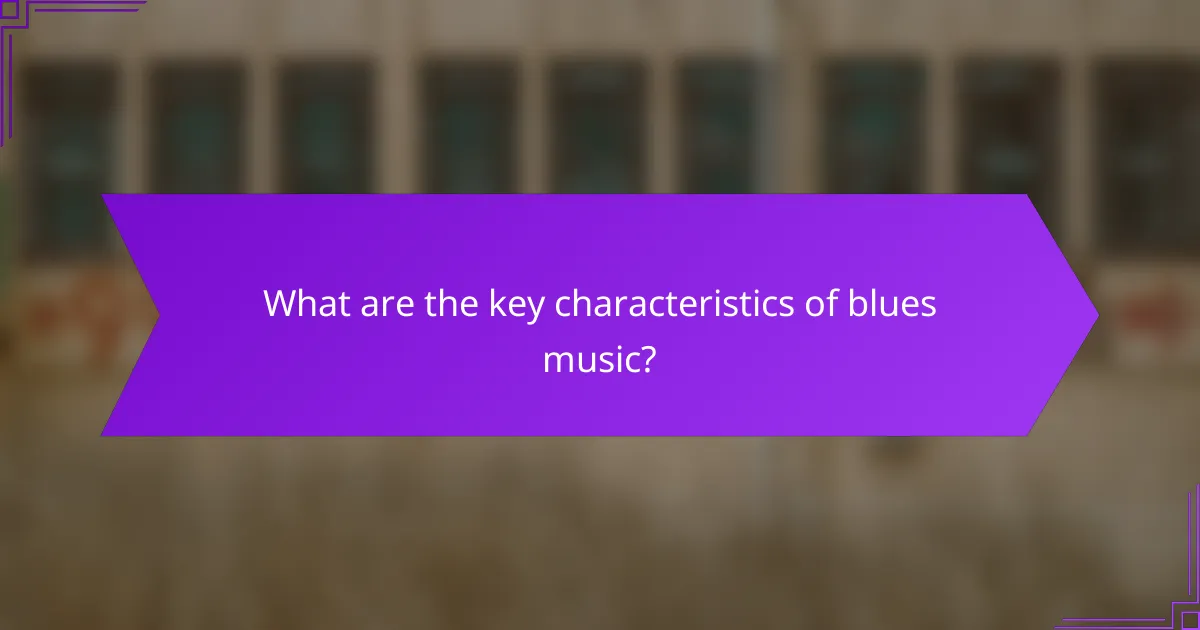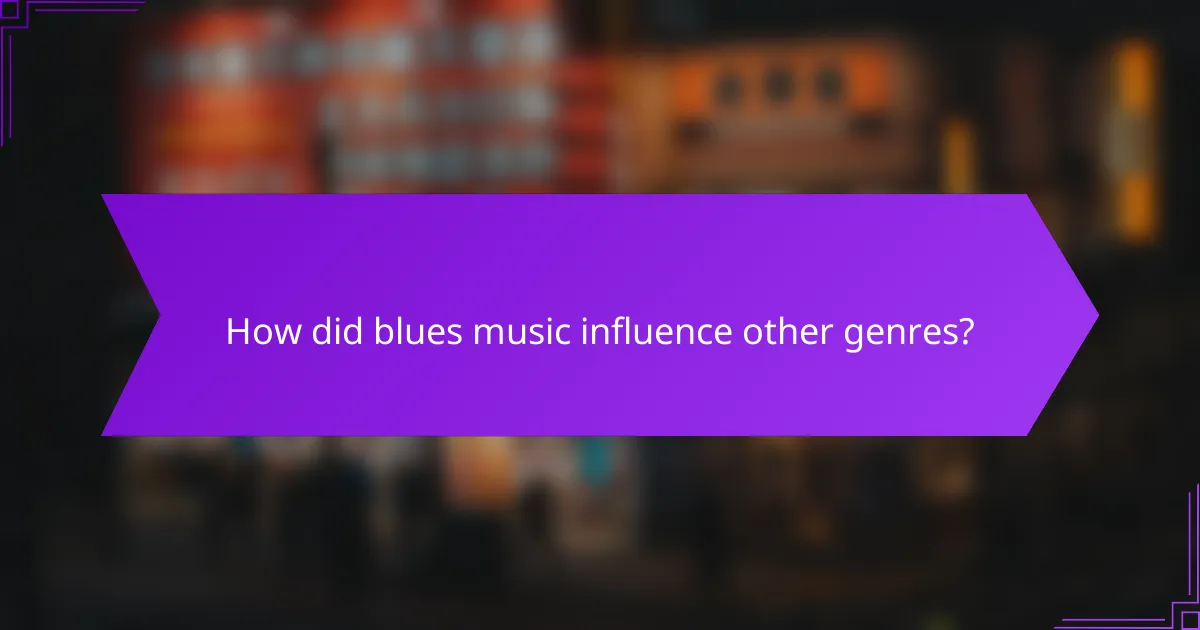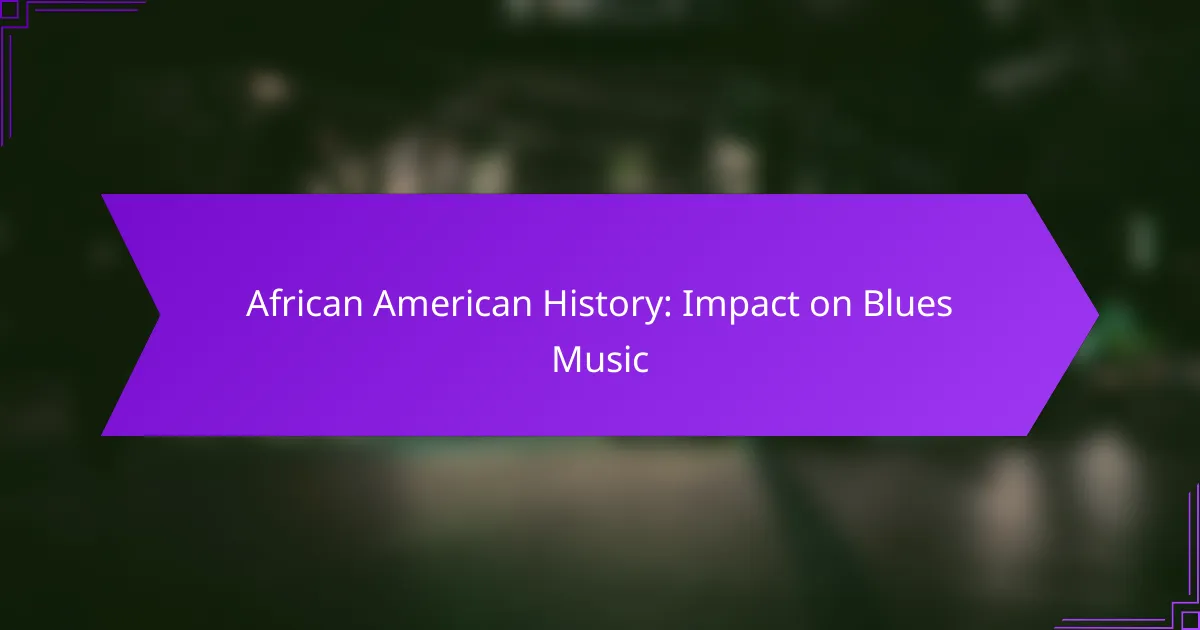African American history has profoundly shaped the development of blues music, serving as a poignant reflection of the struggles and resilience within Black communities. Emerging from the experiences of African Americans, the genre captures themes of heartache and perseverance through its distinctive melodies and emotional lyrics.

How did African American history shape the development of blues music?
African American history significantly influenced the evolution of blues music, reflecting the struggles, resilience, and cultural heritage of Black communities. The genre emerged as a powerful form of expression, rooted in the experiences of African Americans from slavery to the present day.
Influence of slavery on musical expression
The legacy of slavery profoundly impacted musical expression among African Americans, giving rise to a unique blend of African rhythms and European musical elements. Enslaved individuals often used music as a means of communication, storytelling, and emotional release, which laid the groundwork for blues music.
Spirituals, work songs, and field hollers served as early forms of musical expression, characterized by call-and-response patterns and improvisation. These elements became foundational in the development of the blues, allowing artists to convey deep emotions and social commentary.
Role of African cultural traditions
African cultural traditions played a crucial role in shaping the sound and structure of blues music. Elements such as polyrhythms, syncopation, and the use of specific scales can be traced back to various African musical practices. These traditions were adapted and transformed in the context of American life.
Instruments like the banjo, which has African roots, became integral to blues music. The blending of African musical heritage with local influences created a distinct sound that resonated with the experiences of African Americans, further enriching the genre.
Impact of the Great Migration
The Great Migration, which saw millions of African Americans move from the rural South to urban centers in the North, had a significant impact on blues music. This migration facilitated the exchange of musical styles and ideas, as artists brought their experiences and sounds to new audiences in cities like Chicago and Detroit.
As blues music evolved in these urban environments, it incorporated elements from jazz and other genres, leading to the development of subgenres such as Chicago blues. This transformation not only broadened the reach of blues music but also solidified its role as a voice for the African American experience in the 20th century.

What are the key characteristics of blues music?
Blues music is characterized by its expressive melodies, specific chord progressions, and emotional lyrics. It often reflects themes of struggle, heartache, and resilience, rooted in the African American experience.
Musical structure and form
The musical structure of blues typically follows a 12-bar format, which consists of three lines of lyrics over a specific chord progression. This structure allows for improvisation and variation, making each performance unique.
Common chord progressions include the I-IV-V pattern, where musicians use the first, fourth, and fifth chords of a key. This simplicity enables musicians to focus on expression and storytelling, which are central to the genre.
Lyrical themes and storytelling
Blues lyrics often delve into personal experiences, addressing themes such as love, loss, and hardship. This storytelling aspect is crucial, as it connects the listener to the artist’s emotions and experiences.
Many blues songs employ a call-and-response format, where the singer poses a question or statement, and the instrument or audience responds. This interaction enhances the narrative quality and engages listeners more deeply.
Instrumentation and style
Instrumentation in blues music typically includes guitar, harmonica, piano, and bass, with the guitar often taking the lead role. The style can vary from acoustic to electric, each bringing its own flavor to the sound.
Blues guitar techniques, such as bending notes and using slides, contribute to the genre’s distinctive sound. The emotional delivery of vocals, often featuring a raw and gritty quality, is equally important in conveying the song’s message.

Who are the most influential blues musicians?
The most influential blues musicians have shaped the genre through their unique styles and contributions. Artists like B.B. King, Muddy Waters, and Howlin’ Wolf are pivotal figures whose music has left a lasting impact on blues and beyond.
B.B. King
B.B. King, known as the “King of Blues,” revolutionized the genre with his expressive guitar playing and emotive singing. His signature style, characterized by vibrato and string bending, influenced countless musicians across various genres.
King’s most famous songs, such as “The Thrill Is Gone,” showcase his ability to convey deep emotion through music. He often performed with a full band, blending blues with elements of jazz and soul, which expanded the genre’s reach.
Muddy Waters
Muddy Waters is often credited with bringing electric blues to the forefront of American music. His powerful voice and innovative guitar work laid the groundwork for rock and roll, making him a key figure in the transition from acoustic to electric blues.
Hits like “Hoochie Coochie Man” and “Mannish Boy” exemplify his raw energy and storytelling ability. Waters’ music often reflected the struggles and experiences of African Americans in the South, resonating with audiences both locally and nationally.
Howlin’ Wolf
Howlin’ Wolf, known for his deep, growling voice and commanding stage presence, was a major force in the Chicago blues scene. His music combined elements of Delta blues with a more urban sound, making it distinct and powerful.
With songs like “Smoke Stack Lightning” and “Killing Floor,” Howlin’ Wolf’s influence can be seen in the works of many rock and blues artists. His unique approach to rhythm and blues helped shape the genre and inspired future generations of musicians.

What are the regional variations of blues music in the United States?
The regional variations of blues music in the United States reflect the diverse cultural influences and historical contexts of different areas. Key styles include Delta blues from Mississippi, Chicago blues that evolved from earlier forms, and Texas blues, each with distinct characteristics and instrumentation.
Delta blues in Mississippi
Delta blues originated in the Mississippi Delta, characterized by its raw emotional expression and simple, yet powerful, instrumentation. Typically featuring solo artists with acoustic guitars, this style often incorporates slide guitar techniques and haunting vocals.
Notable artists like Robert Johnson and Muddy Waters exemplified Delta blues, using their music to convey personal and social struggles. The sound is often marked by a slow tempo and a focus on storytelling, making it deeply resonant with listeners.
Chicago blues evolution
Chicago blues emerged as musicians migrated from the South to urban areas, particularly Chicago, during the Great Migration. This style incorporates electric instruments, creating a fuller sound that blends traditional blues with jazz and rhythm and blues elements.
Artists such as Howlin’ Wolf and Buddy Guy played a significant role in this evolution, often performing in clubs and using amplified guitars and harmonicas. The Chicago blues scene became a hub for innovation, leading to the development of rock and roll.
Texas blues characteristics
Texas blues is known for its distinctive blend of country, jazz, and blues influences, featuring both acoustic and electric guitars. This style often includes a more upbeat tempo and a strong emphasis on improvisation, showcasing the musicians’ technical skills.
Prominent figures like Stevie Ray Vaughan and T-Bone Walker contributed to the Texas blues sound, incorporating elements such as swing rhythms and intricate guitar solos. The genre’s versatility allows for a wide range of emotional expression, from joyful to deeply reflective themes.

How did blues music influence other genres?
Blues music has profoundly influenced various musical genres by introducing its unique rhythms, emotional depth, and structural elements. Its impact can be seen in rock and roll, jazz, R&B, and even hip-hop, shaping the sound and style of these genres.
Impact on rock and roll
Rock and roll emerged in the 1950s, heavily borrowing from the blues’ chord progressions and expressive vocal techniques. Artists like Chuck Berry and Elvis Presley integrated blues elements, creating a sound that resonated with a broader audience.
The 12-bar blues structure became a foundational element in rock music, allowing for improvisation and emotional expression. This connection laid the groundwork for countless rock subgenres, from classic rock to punk.
Influence on jazz and R&B
Jazz musicians adopted the blues scale and improvisational style, leading to the development of jazz blues, a subgenre that combines elements of both. Artists such as Louis Armstrong and B.B. King exemplified this fusion, showcasing the emotional depth of blues within jazz contexts.
R&B, which evolved in the 1940s, also drew heavily from blues, incorporating its themes of love and hardship. The genre’s rhythmic and melodic structures often reflect blues influences, making it a direct descendant of this rich musical tradition.
Connection to hip-hop
Hip-hop has roots in blues through its storytelling and emotional expression, often addressing social issues and personal struggles. Many hip-hop artists sample blues tracks, using their melodies and rhythms to create a new context for their lyrics.
The connection is evident in the works of artists like Jay-Z and Kanye West, who have incorporated blues elements to enhance their storytelling. This blending of genres illustrates the enduring legacy of blues music in contemporary sounds.

What are the current trends in blues music?
Current trends in blues music reflect a blend of traditional elements and modern influences, showcasing the genre’s evolution while honoring its roots. Artists are increasingly experimenting with new sounds, leading to a dynamic landscape that appeals to both long-time fans and new listeners.
Revival of traditional blues
The revival of traditional blues focuses on preserving the classic sounds and styles that define the genre. Musicians are returning to the acoustic roots of blues, often incorporating slide guitar, harmonica, and soulful vocals reminiscent of early legends like Muddy Waters and B.B. King.
Festivals and local venues dedicated to traditional blues have seen a resurgence, attracting audiences eager to experience authentic performances. This trend emphasizes storytelling and emotional expression, key elements that resonate deeply with listeners.
Fusion with contemporary genres
Blues music is increasingly fusing with contemporary genres such as rock, jazz, and hip-hop, creating innovative sounds that broaden its appeal. Artists like Gary Clark Jr. and Joe Bonamassa exemplify this trend by blending traditional blues with modern instrumentation and production techniques.
This fusion allows blues to reach younger audiences while maintaining its core emotional depth. Collaborations between blues musicians and artists from other genres often result in unique tracks that push creative boundaries and introduce blues to diverse fan bases.



